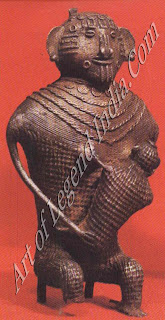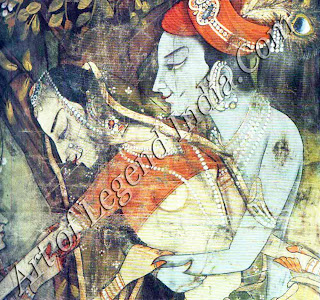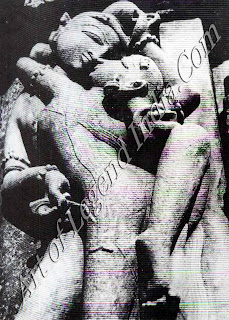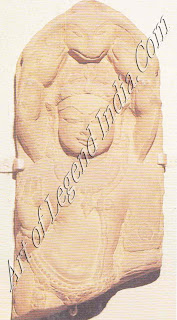 The
Dravidian beliefs were deeply enough entrenched in India to survive the changes
brought about by the successive waves of Aryan invasion that took place from
about i800 B.C. and led to or at least coincided with the decline and
disappearance of the Indus Valley cities. In a number of particulars the
iconography of the Indus Valley civilisation, and therefore possibly beliefs,
'reappears with the first Hindu cult images of gods of the firstto
fourth centuries A.D. Thus Shiva and his consort resemble the Dravidian cult
figures in many respects, Shiva often being depicted in a cross-legged yogic
posture with the bull Nandi as his symbol, and his consort being associated
with human sacrifice. Other Hindu deities too are characteristically
accompanied by particular animals, often a 'vehicle'. And the graceful yakshi
figures that feature so prominently in early Buddhist sculpture of the third to
first centuries B.C., when no images of the Buddha himself were made, appear to
be derived from Dravidian female nature deities associated with trees and water
and symbolising the fertility of water and earth. As in the Indus civilization
seals, they are accompanied by naturalistic animals, and some-times by a male
ministrant or counterpart, the yaksha. Such figures later influenced the
depiction of the Buddha in the sculptures made at Mathura and installed at
Sarnath.
The
Dravidian beliefs were deeply enough entrenched in India to survive the changes
brought about by the successive waves of Aryan invasion that took place from
about i800 B.C. and led to or at least coincided with the decline and
disappearance of the Indus Valley cities. In a number of particulars the
iconography of the Indus Valley civilisation, and therefore possibly beliefs,
'reappears with the first Hindu cult images of gods of the firstto
fourth centuries A.D. Thus Shiva and his consort resemble the Dravidian cult
figures in many respects, Shiva often being depicted in a cross-legged yogic
posture with the bull Nandi as his symbol, and his consort being associated
with human sacrifice. Other Hindu deities too are characteristically
accompanied by particular animals, often a 'vehicle'. And the graceful yakshi
figures that feature so prominently in early Buddhist sculpture of the third to
first centuries B.C., when no images of the Buddha himself were made, appear to
be derived from Dravidian female nature deities associated with trees and water
and symbolising the fertility of water and earth. As in the Indus civilization
seals, they are accompanied by naturalistic animals, and some-times by a male
ministrant or counterpart, the yaksha. Such figures later influenced the
depiction of the Buddha in the sculptures made at Mathura and installed at
Sarnath.
The
Dravidian peoples, who spread into almost every part of India and Sri Lanka,
were a mixture of native populations of India and Proto-Drav-Indians, who seem
to have entered India in waves from about 4000 to 2500 B.C. They introduced a
neolithic village culture based on agriculture or hunting in Baluchistan and
Sind, and this enriched and incorporated elements of the mesolithic culture
evidenced about 5000 B.C. by the earliest known paintings in rock shelters of
bison, elephant and buffalo, as far afield as Adamgarh in central India and
Badami in the southern Deccan. The so-called Indus Valley civilisation which
developed from this stretched from Afghanistan to beyond present Delhi and from
the Makeran coast of Baluchistan far down into Gujerat. Great cities such as
Mohenjodaro and Harappa (in present-day Pakistan) and Kalibangan in India rose
during the third millennium B.C. and reached the height of their considerable
material culture about 2150-1750 B.C. (as Carbon-14 dating has shown, somewhat
later than thought when the sites were first excavated in the 19zos).
From
the archaeological excavations it is clear that the great cities had risen
above a purely agricultural economy and conducted trade over-land and by sea
with places as far afield as Mesopotamia. The Sumerian-style seals found at
each of the major sites give us the best clues to what their deities and myths
may have been, though the accompanying inscriptions have not so far been
satisfactorily deciphered. Nor can we know whether the remarkable visual
similarities indicate beliefs derived from Mesopotamia or merely an iconography
borrowed from there.
Whatever
the case, the Dravidians, as an agricultural people, clearly worshipped deities
connected in one way or another with fertility. There were two main elements in
this, both analogous to Mesopotamian cults: phallic worship typified in the
seals found at Harappa, which show a god seated with legs crossed and wearing
bull's horns (the bull being a universal symbol of male potency); and the cult
of mother goddesses, most plainly depicted on seals which show plants growing
from the womb of a female deity, or which show a naked goddess before whom a
human sacrifice is being performed. Such figures are accompanied by animal
ministrants, the goddess by what appears to be half-bull, half-ram, and the god
by deer, birds, an elephant, a tiger, a rhinoceros and a buffalo or in other
cases by votive serpents. Serpent worship certainly antedates the Aryan
invasions, though it was incorporated into both Buddhist and Hindu iconography.
Significantly, from Aryan times onwards the majority of serpents or Nagas were
considered demons, but a few were highly honoured as divine. This age old
reverence for animals, alien to Aryan belief, may well have contributed to
Buddhist and Hindu ideas of reincarnation.
 The
Dravidian beliefs were deeply enough entrenched in India to survive the changes
brought about by the successive waves of Aryan invasion that took place from
about i800 B.C. and led to or at least coincided with the decline and
disappearance of the Indus Valley cities. In a number of particulars the
iconography of the Indus Valley civilisation, and therefore possibly beliefs,
'reappears with the first Hindu cult images of gods of the firstto
fourth centuries A.D. Thus Shiva and his consort resemble the Dravidian cult
figures in many respects, Shiva often being depicted in a cross-legged yogic
posture with the bull Nandi as his symbol, and his consort being associated
with human sacrifice. Other Hindu deities too are characteristically
accompanied by particular animals, often a 'vehicle'. And the graceful yakshi
figures that feature so prominently in early Buddhist sculpture of the third to
first centuries B.C., when no images of the Buddha himself were made, appear to
be derived from Dravidian female nature deities associated with trees and water
and symbolising the fertility of water and earth. As in the Indus civilization
seals, they are accompanied by naturalistic animals, and some-times by a male
ministrant or counterpart, the yaksha. Such figures later influenced the
depiction of the Buddha in the sculptures made at Mathura and installed at
Sarnath.
The
Dravidian beliefs were deeply enough entrenched in India to survive the changes
brought about by the successive waves of Aryan invasion that took place from
about i800 B.C. and led to or at least coincided with the decline and
disappearance of the Indus Valley cities. In a number of particulars the
iconography of the Indus Valley civilisation, and therefore possibly beliefs,
'reappears with the first Hindu cult images of gods of the firstto
fourth centuries A.D. Thus Shiva and his consort resemble the Dravidian cult
figures in many respects, Shiva often being depicted in a cross-legged yogic
posture with the bull Nandi as his symbol, and his consort being associated
with human sacrifice. Other Hindu deities too are characteristically
accompanied by particular animals, often a 'vehicle'. And the graceful yakshi
figures that feature so prominently in early Buddhist sculpture of the third to
first centuries B.C., when no images of the Buddha himself were made, appear to
be derived from Dravidian female nature deities associated with trees and water
and symbolising the fertility of water and earth. As in the Indus civilization
seals, they are accompanied by naturalistic animals, and some-times by a male
ministrant or counterpart, the yaksha. Such figures later influenced the
depiction of the Buddha in the sculptures made at Mathura and installed at
Sarnath.
The yakshi
and yaksha figures survived into Hinduism too, in trans-muted though still
powerful form, as guardians of wealth, and they are thought to have influenced
the development in India of cosmic sexual symbolism. From being
personifications of the ever-renewing sap of life, whose embrace has the power
to fertilise trees, yakshis developed into the three great female deities of
Indian rivers, Ganga, Yamuna and Sarasvati, source of eternal sustenance, and
so into the culminating personification of abundance, the goddess Lakshmi. In
Tantric belief, whose influence is so strongly reflected in the countless
images of Mithuna, embracing couples, that adorn Indian temples, the female
principle of voluptuous activity is the motive force that sustains the universe,
because without it the male principle of static, transcendental potentiality
would remain in inert passivity. They illustrate, to European eyes sometimes in
gross physical form, spiritual union with the divine. This Tantric trend, which
became powerful in the fifth century A.D. during the Golden Age of the Gupta
empire, is in striking contrast to the ascetic stream in Indian tradition, yet
both seem equally to derive from the pre-Aryan past, and stand in a dialectical
relationship to each other, opposite poles of the human approach to existence.
Writer-
Veronica Lons
Subscribe to:
Post Comments (Atom)














0 Response to "Early Deities of Indian Mythology"
Post a Comment